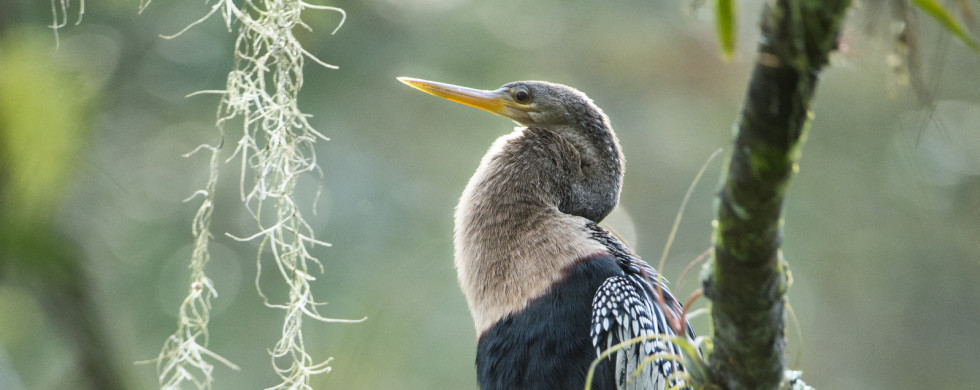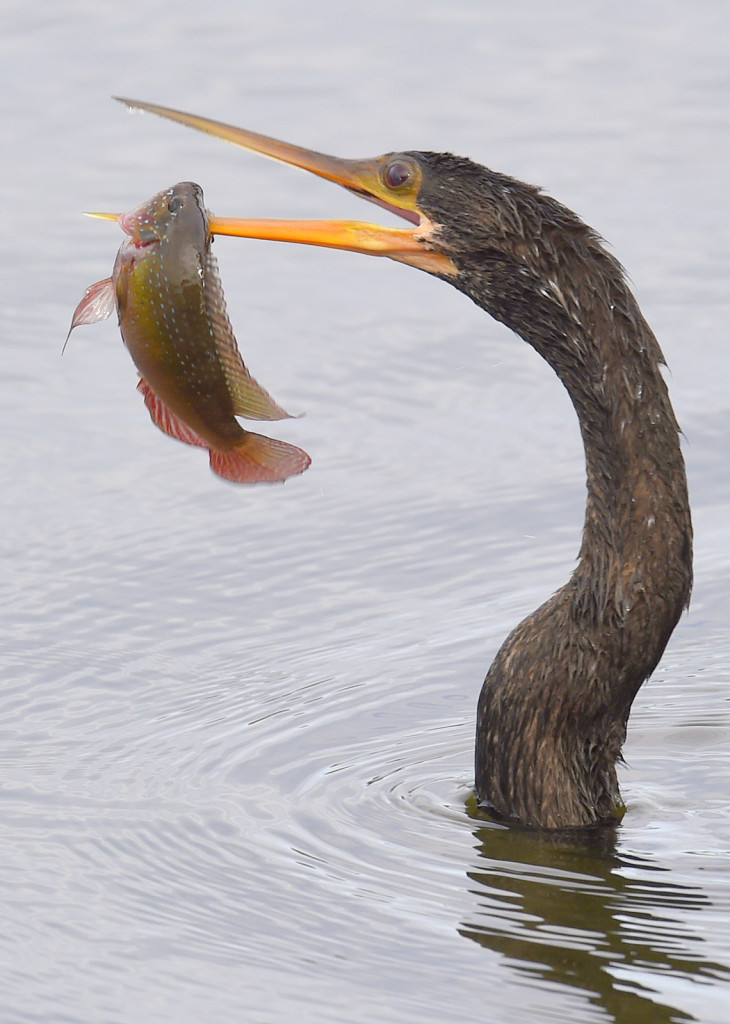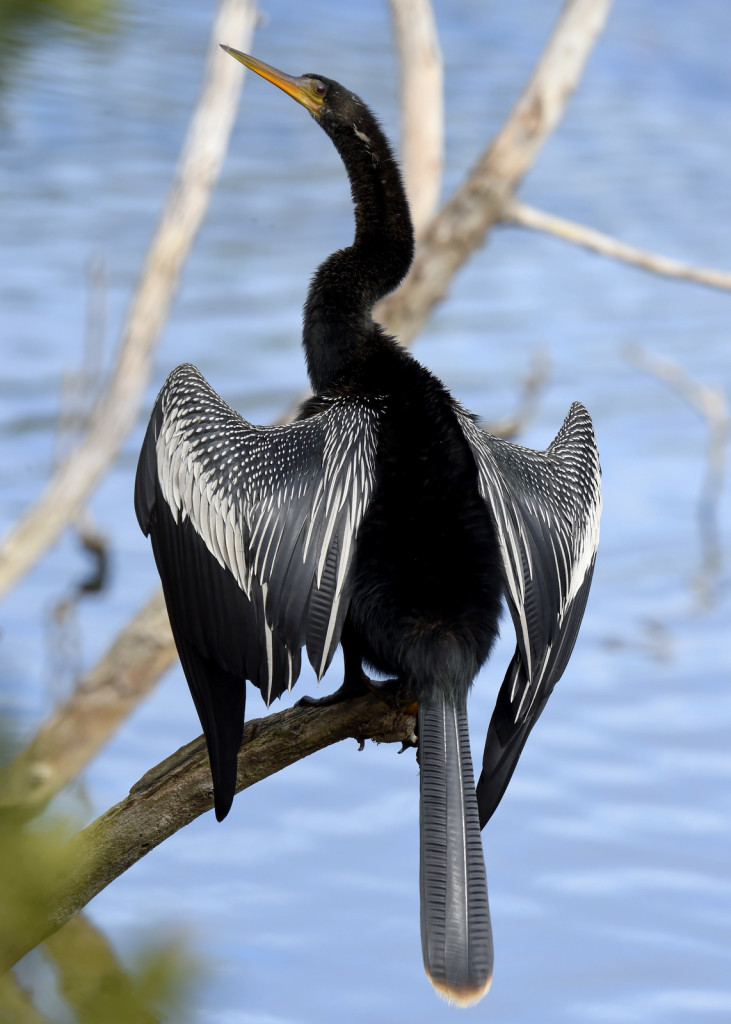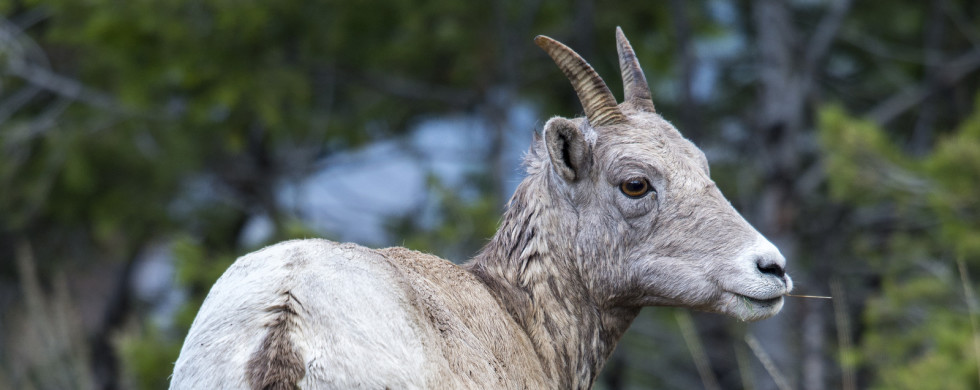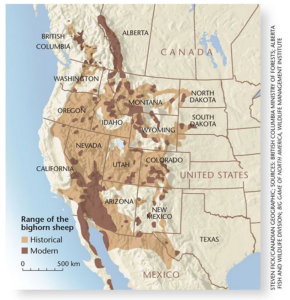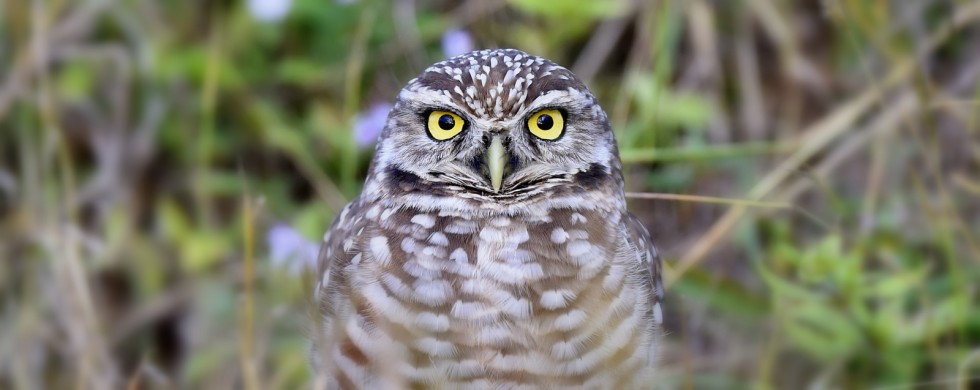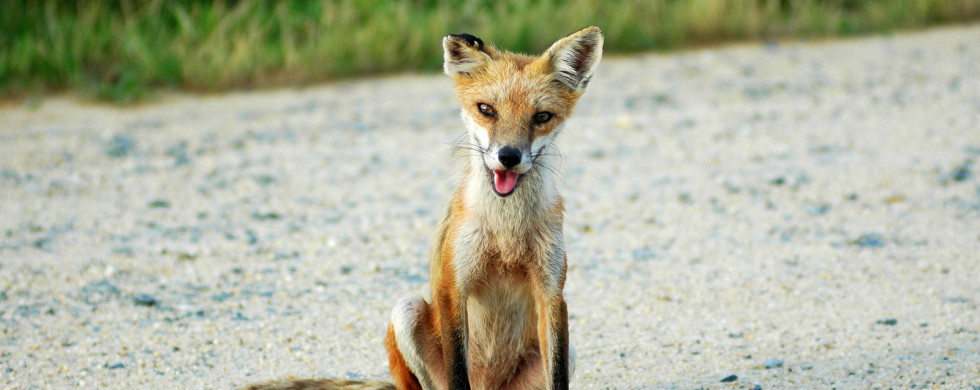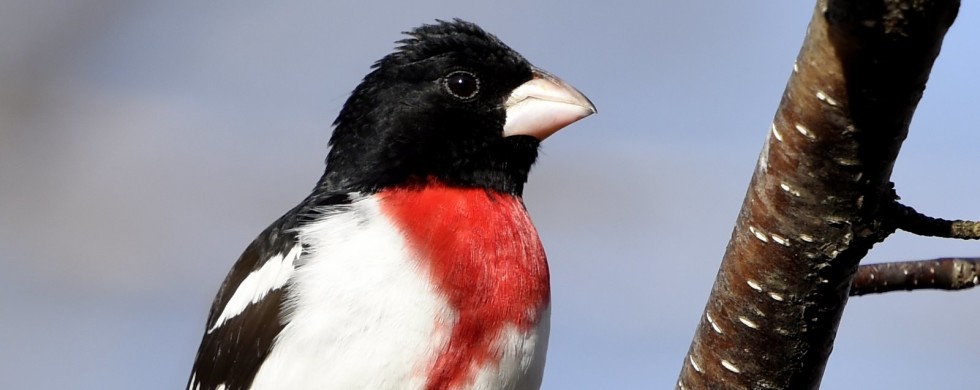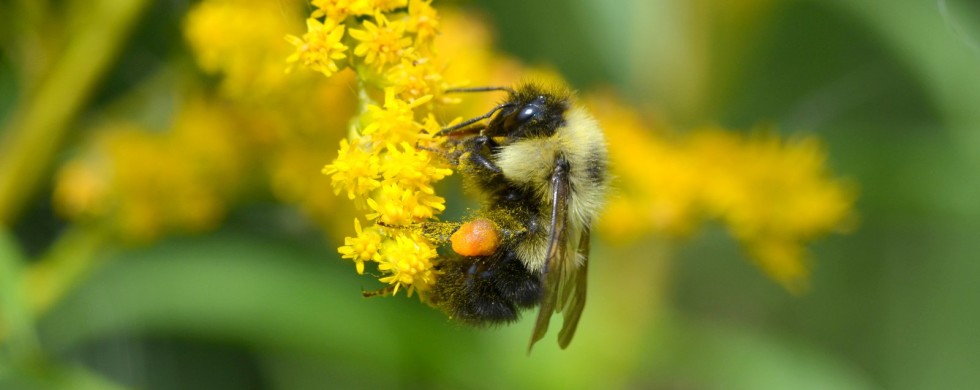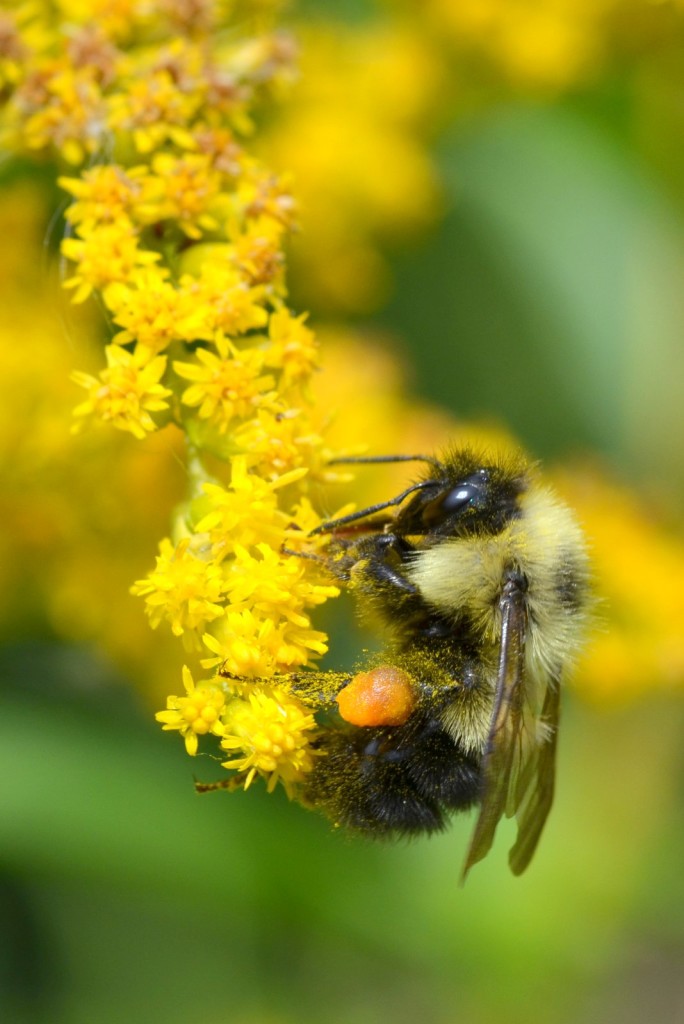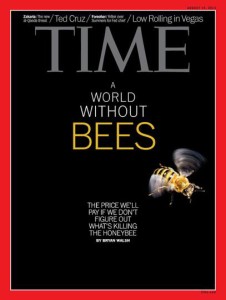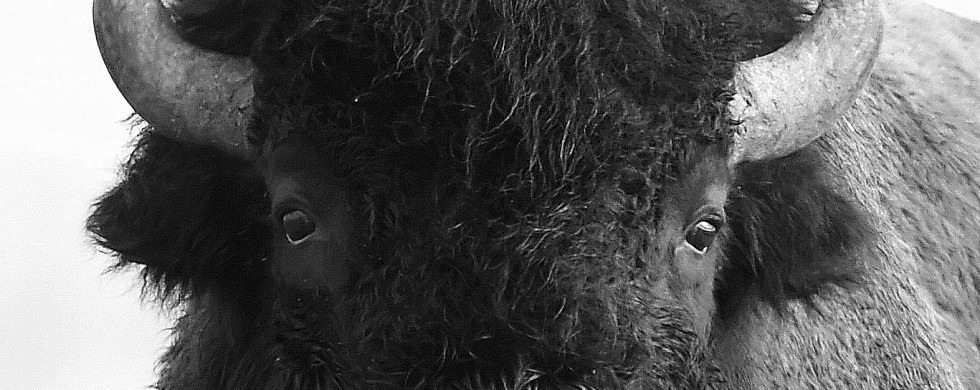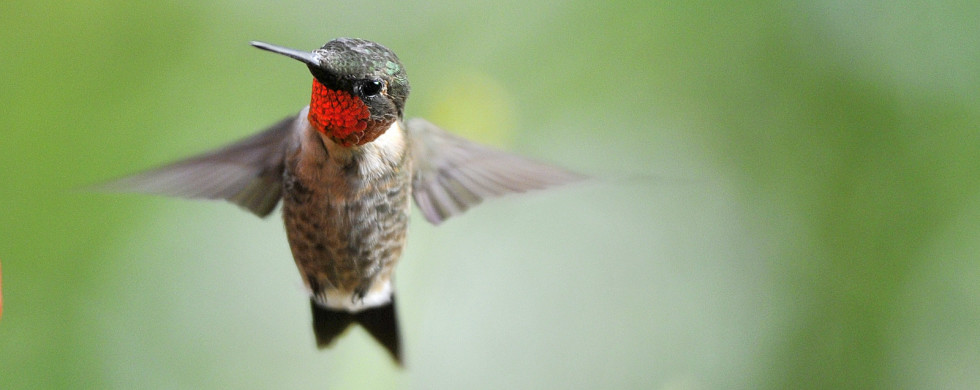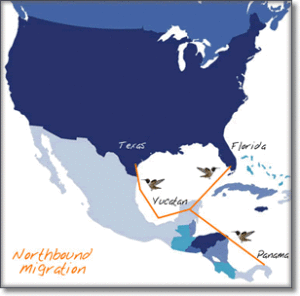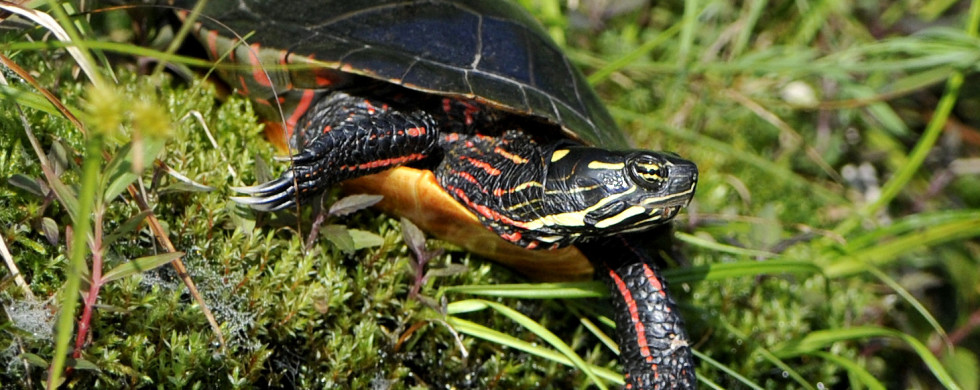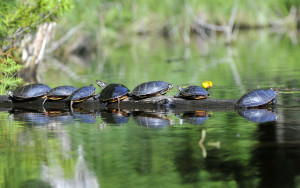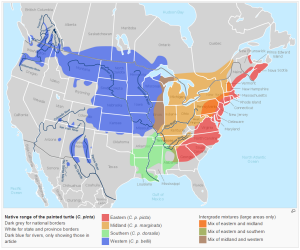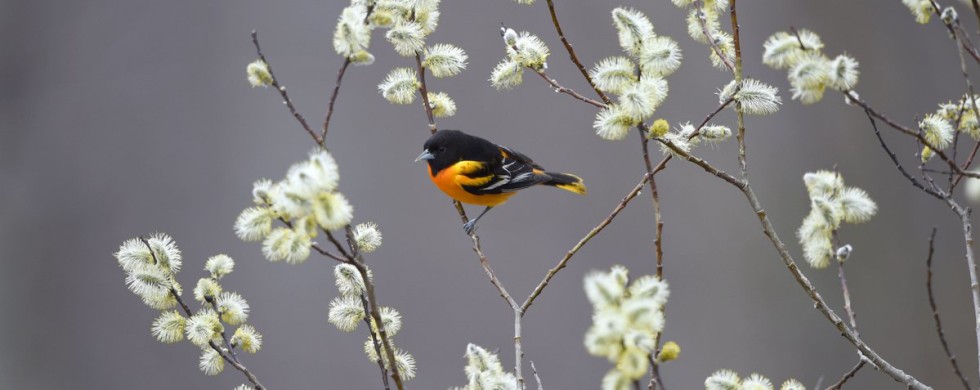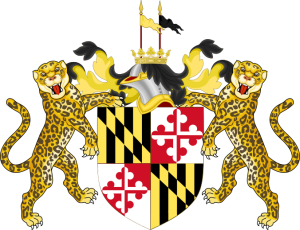29
Shot of the Month – February 2016
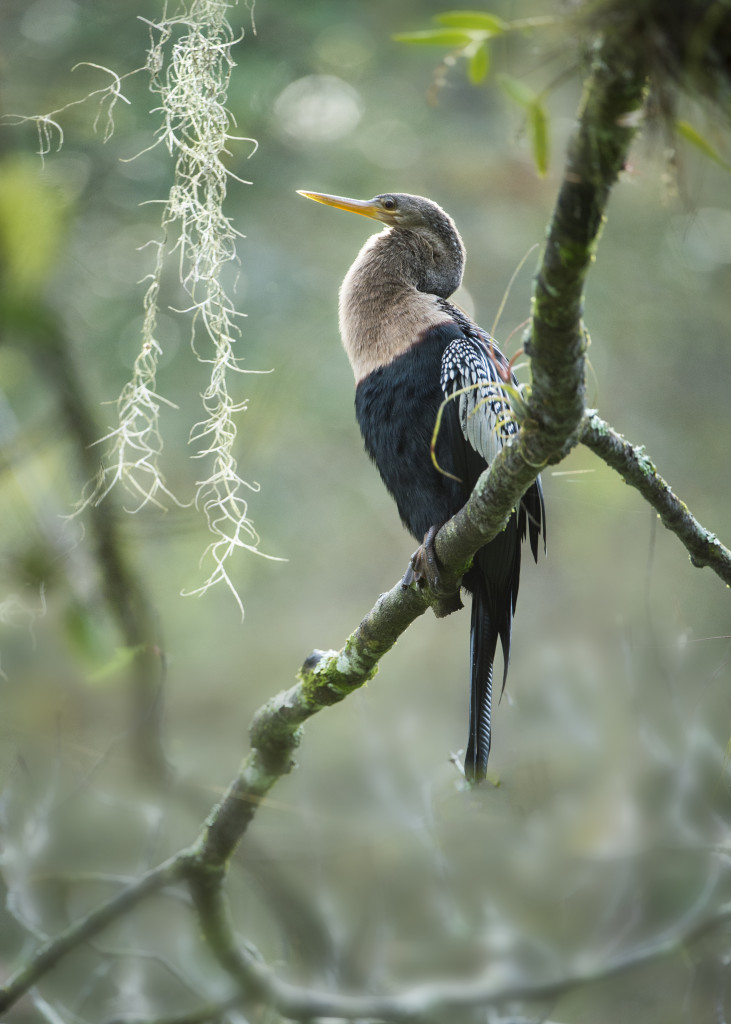 This month a serene swamp scene with the “Devil Bird.” No insult intended toward our fine feathered friend but that is what Anhinga means in the Brazilian Tupi Language — but I am sure that you knew that. The Anhinga is also known as the “Snake Bird” or the “Water Turkey.” What gives with all the nicknames? Well, each refers to different characteristics of this bird which is a type of darter. Darter? Sigh….so many things to learn in life. Darters are made up of 4 species of birds found in the Anhingidae family. The American darter, or Anhinga is found in the Western Hemisphere. The Oriental darter is found in Asia. You can guess where the African darter and Australian darter can be found, respectively. Zero points for creativity on the naming front.
This month a serene swamp scene with the “Devil Bird.” No insult intended toward our fine feathered friend but that is what Anhinga means in the Brazilian Tupi Language — but I am sure that you knew that. The Anhinga is also known as the “Snake Bird” or the “Water Turkey.” What gives with all the nicknames? Well, each refers to different characteristics of this bird which is a type of darter. Darter? Sigh….so many things to learn in life. Darters are made up of 4 species of birds found in the Anhingidae family. The American darter, or Anhinga is found in the Western Hemisphere. The Oriental darter is found in Asia. You can guess where the African darter and Australian darter can be found, respectively. Zero points for creativity on the naming front.
I photographed this Anhinga in Corkscrew Swamp in Florida. These birds prefer hot climates and their range includes the southern United States and extends south into Mexico, through Central America down to Argentina. (See a Range Map here)
So what gives with the Snake Bird reference? Anhingas are waterbirds that hunt for fish while swimming underwater or at the surface. They can dive quite deep as they have rather dense bones and their wings are not very waterproof so the soaked feathers help weigh the birds down reducing their buoyancy even more.
Like all darters, Anhingas use that sharp beak to spear fish. The devil bird is not a fast swimmer so its hunting style is more stalker than chaser. He mostly swims slowly underwater waiting for a fish to come near, then he impales the fish with a lightning-fast thrust of the beak. The neck is specially adapted for this kind of rapid thrust — the 8th and 9th cervical vertebrae create a hinge-like apparatus that allows for quick action. The bird usually stabs a fish through their sides with both mandibles open though he may just use the upper mandible for small fish. (Source)
That’s all very interesting, but I still haven’t explained the snake reference. OK, here is it. The Anhinga swims lower in the water than many birds due to its reduced buoyancy, a result of its dense bones and wetted plumage. When at the water’s surface, typically only the long neck and head are visible and the bird looks like a snake gliding across the water. Mystery solved.
Ok, and what about “Water Turkey?” Turns out that Anhingas lose heat quickly while in the water due to their lack of an insulating layer of body feathers. To deal with this they spend much of the day, like cormorants, perched on a snag with their wings spread and feathers fanned out to dry and raise their body temperature. Their wide, fanned-out tail reminds folks of another large, dark bird with a large tail — yep, da turkey.
Male Anhingas are glossy black and have silver patches on their wings. The female Anhinga looks similar though her head, neck, and upper chest tend to be pale gray or light brown. From this, we can see that we have a female snake bird in my swamp image. In the below image, we see a male Anhinga catching some rays.
There you have it, the American Darter, the shapeshifter of the swamp, aka, Anhinga, part turkey, part snake, and definitely the devil if you are a fish.
Until next month….m
Here is a good video on the Anhinga in action.
Nikon D4S, Nikon 200-400mm (@ 380mm), f/4, 1/400 s, -0.5 EV, ISO 1100,
31
Shot of the Month – January 2016
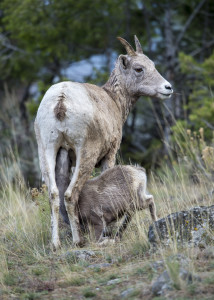 If you just look quickly at this shot you might think, “Huh, nice goat thing” and move along. But if you look a bit closer you will see that we have a lovely mountain maternal moment going on here. See the dining lamb? Lower…..bingo, there you go.
If you just look quickly at this shot you might think, “Huh, nice goat thing” and move along. But if you look a bit closer you will see that we have a lovely mountain maternal moment going on here. See the dining lamb? Lower…..bingo, there you go.
As it turns out, the goat is actually a sheep, a Bighorn sheep to be exact. I photographed this one in Yellowstone NP. The name is a bit of a misnomer for the ewe as you can see that her horns are not all that big. As it often goes with species naming, the glory goes to the Y chromosome holder. The Bighorn males get all of the attention due to their massive horns and tendency to want to smash them into another ram to prove who’s the biggest and baddest ram in town. The last sheep standing gets the right to date all the cute ewes in the hood. It’s a dramatic show to be sure, but that is a story for another day.
Bighorn sheep can be found in the mountainous regions of North America from southern Canada to Mexico. At the beginning of the 18th century, there were about 1.5 to 2 million bighorn sheep in North America. Then humans did what they do and by 1920 the sheep had been wiped out in Washington, Oregon, Texas, North Dakota, South Dakota, Nebraska, and part of Mexico. So, in about 120 years the number of Bighorn Sheep dropped from a couple of million to a few thousand. There are about 70,000 sheep left on the continent now and about 400 Bighorn sheep remaining in Yellowstone NP. Sigh. (Source)
The map below shows the historical range of the sheep and their current locations.
The sheep were saved from extinction, in part, thanks to the efforts of the Arizona Boy Scouts. Major Frederick Russell Burnham, a famous conservationist and renowned “Father of Scouting” noticed that less than 150 sheep were remaining in Arizona in 1936 (I never heard of the guy but he had an amazing life. Learn more about him here). He called George Miller, the head of the scout movement in Arizona at the time, and told him that he wanted the scouts to save the sheep. What Fred wants, Fred gets — The scouts started a “Save the bighorns” poster campaign in schools across the state and other conservation groups joined the effort (i.e. The National Wildlife Federation, the Izaak Walton Foundation, and the National Audubon Society). These efforts led to the creation of two protected parks in Arizona and conservation efforts in other states began to improve the situation for the sheep. (Source)
Bighorn sheep are well adapted to life in the mountains and they can traverse ledges that are only 2 inches wide. Bighorn sheep are related to goats (you can certainly see the resemblance in my photo) and their split hooves make them quite sure-footed. The outer hooves are modified toenails that are shaped to snag any slight protrusion, while soft inner pads provide a good grip on uneven surfaces. In the winter the sheep descend to lower-elevation mountain pastures to find food and avoid the deep snow found higher up. During the summer the sheep will return to higher elevations to avoid the heat and predators typically found in the valleys (wolves, cougars, coyotes, bears, etc., oh my)
We almost pushed Bighorn Sheep off the evolutionary cliff but they have made a bit of a comeback thanks to recent conservation efforts. However, given the rising pressure from human encroachment, climate change, and poachers the future for these alpine sheep is still a cliff-hanger at best.
Until next month…..m
Nikon D4S, Nikon 600mm, f/5.6, 1/250 s, ISO 800
31
Shot of the Month – December 2015
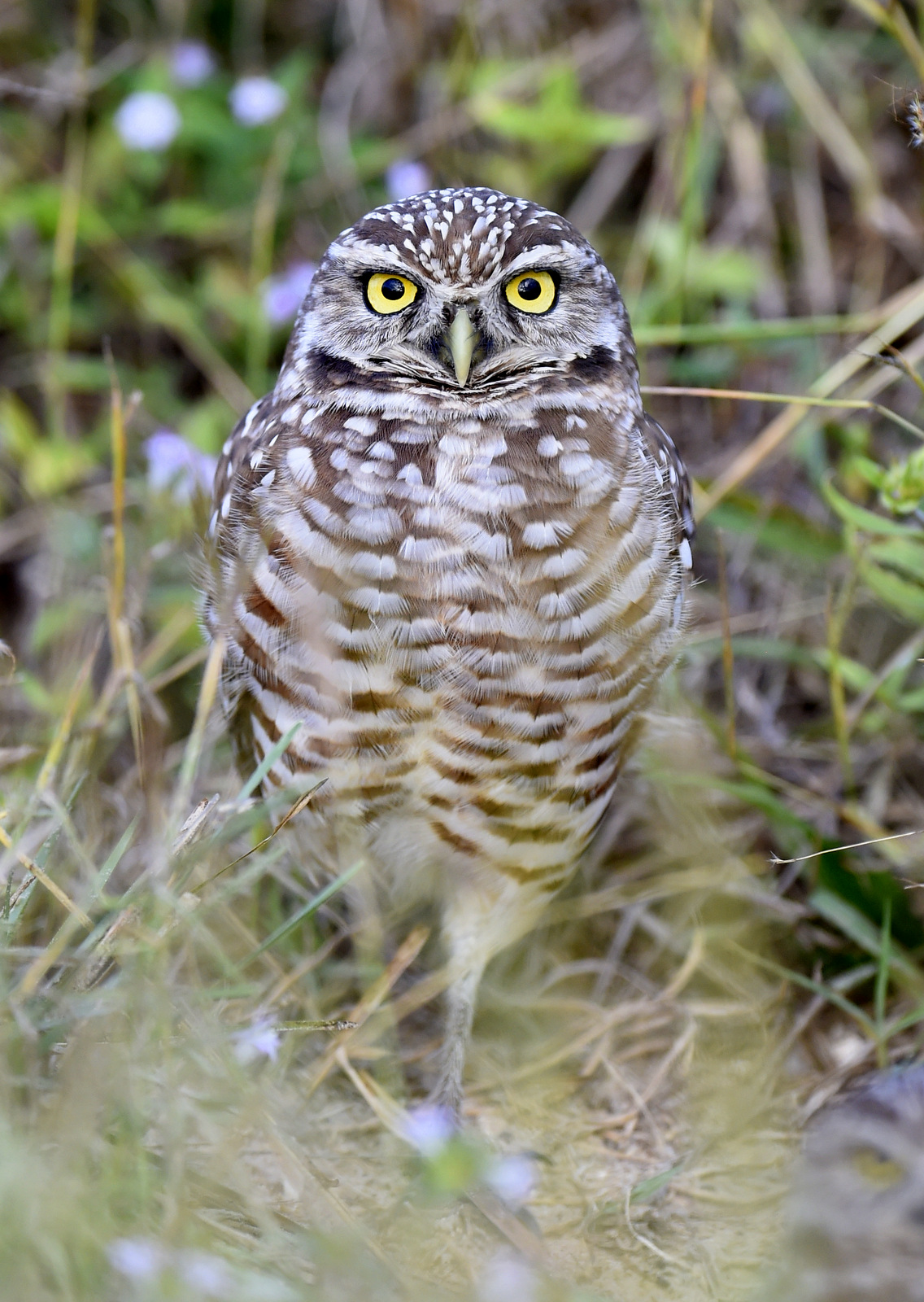 Ok, their official name is Burrowing Owl (BO) but my title better captures how most people react to this pint-size beauty. I posted this image on my Facebook Photopage and the reaction was off the charts even though the photo is really just so-so in my opinion. That damn grass in the foreground!
Ok, their official name is Burrowing Owl (BO) but my title better captures how most people react to this pint-size beauty. I posted this image on my Facebook Photopage and the reaction was off the charts even though the photo is really just so-so in my opinion. That damn grass in the foreground!
Here we have a static bird staring at the lens in “just ok” light — but here is an example where excessive cuteness (owfully cute?) wins out over composition. And those EYES…I could get lost in there for days…..swoon…
While most birds spend most of their time in the trees, these owls, as you may have gleaned from their name, actually spend the majority of their time on the ground and live underground in, yep you guessed it, burrows.
In the US, Florida is the only east coast location to see a Burrowing Owl. Otherwise, head west or south, and depending on the time of year, you can find them in Canada down through Mexico into Central America. Some species can also be found on various Caribbean Islands and others in parts of South America.
Historically BO’s prefer open prairies and cleared areas with short grass. In modern times they can be also found in pastures, farm fields, golf courses, airports, and vacant lots in residential areas. I actually photographed this fella in an empty lot in the suburbs of Cape Coral, Florida.
Florida BOs usually dig their own burrows, but those in the western part of the US typically use old burrows left by prairie dogs, ground squirrels, kangaroo rats, armadillos, or other animals. Burrows excavated by the owls may be up to 6-10′ long, with a nest chamber at the end.
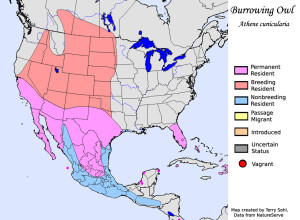
Burrowing Owl Range (Source)
Burrowing Owls are some of the smallest owls in North America. These guys stand about 7-11 inches tall and weigh about 4-8 ounces. To give you a sense of scale, the BO is slightly larger than an American Robin!
Despite their small size these guys seem to have a Big sense of humor — did you notice the bird in the lower right corner of the picture?
Boom! Photobombed, baby!
Until next month….michael
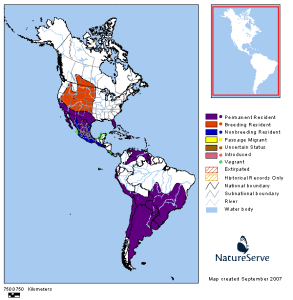
Extended Range of Burrowing Owl (Source)
Nikon D4S, 600mm, f/4, 1/1000 sec, 1400 ISO, +1 EV
30
Shot of the Month – November 2015
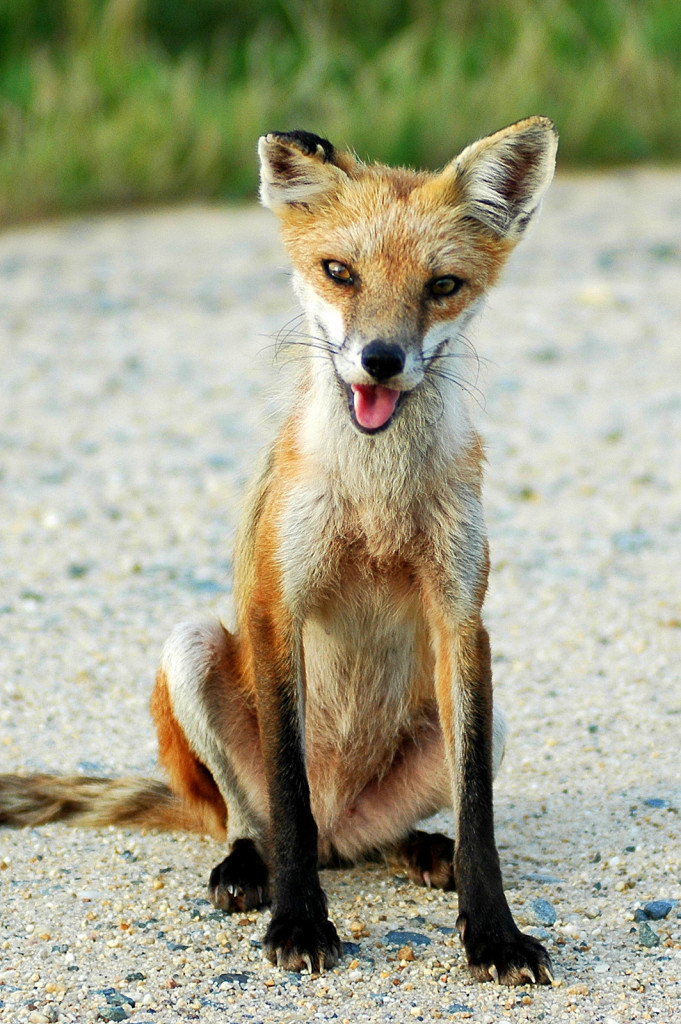 Could this be a wanted poster for one of nature’s craftier criminals? Or just a cute poster of a cuddly critter?
Could this be a wanted poster for one of nature’s craftier criminals? Or just a cute poster of a cuddly critter?
Just like a canine Jesse James, there is no shortage of tall tales that cast the fox’s character across the spectrum from saint to sinner and everything in between.
Regardless of your particular point of view, there is no disputing that humans are fascinated by this little fellow and use him as a foil for human fortitude and frailty alike.
Foxes got their first documented curtain call in 4 BC in Aesop’s fables in The Fox and the Grapes. Greek mythology engaged the Teumessian fox to devour children, and foxes appear in Celtic mythology as shapeshifters.
In Chinese, Japanese, and Korean (Kumiho) folklore foxes are powerful spirits that are known for their highly mischievous and cunning nature, often taking the form of female humans to seduce men.
In Arab folklore, the fox is weak and deceitful. In the Bible, the word “fox” is applied to false prophets (Ezekiel 13:4) and the hypocrisy of Herod Antipas (Luke 13:32). Foxes are very popular in Native American mythology and can be found in Achomawi, Yurok tribe, Inuit, and Menominee folk stories (But, you knew that…)
Our lexicon is riddled with foxy lingo.
- “fox/foxxy” = slang for someone with sex appeal
- “outfox” = means to beat in a competition of wits
- “vixen” = a female fox is called a vixen, it is also used to describe an attractive woman, though implies some questionable character traits…
- “shenanigan” = (as in deceitful confidence trick, or mischief) is derived from the Irish expression sionnachuighim, meaning “I play the fox”
In World War II, Erwin Rommel, the German commander in North Africa, was called the “Desert Fox” by his British adversaries, as a tribute to his operational cunning and skill.
I could go on and on. Foxes can be found on every continent except Antarctica and basically, just about every culture has assigned the fox archetype traits or powers. Foxes can be found in plays, novels, children’s books, TV shows, video games, movies, anime, music (Foxy Lady), opera, and well, just about everywhere. Go here to see an amazingly long and comprehensive list of all the cultural references through the ages.
Ahh, the crafty fox, the Dr. Who of the natural world….he is the lingua franca across countries, culture, time and space. And very cute.
Nikon D70, Nikkor 80-200 f/2.8 (@ 80mm), 1/1000s, ISO 200
31
Shot of the Month – October 2015
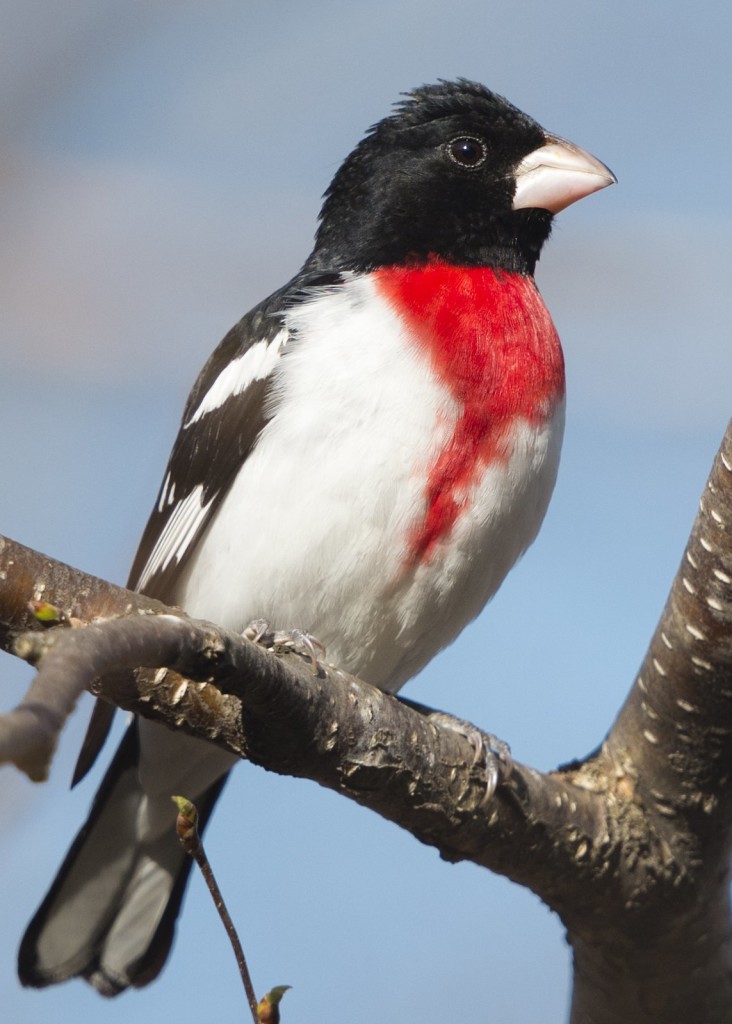 As you can see, the Rose-breasted Grosbeak (RBG) is a striking-looking fellow. And not only is he good-looking, this guy has a lovely voice. His double threat traits strike a chord with the ornithological crowd and stir flight of fancy and poetic prose.
As you can see, the Rose-breasted Grosbeak (RBG) is a striking-looking fellow. And not only is he good-looking, this guy has a lovely voice. His double threat traits strike a chord with the ornithological crowd and stir flight of fancy and poetic prose.
A few of my favorite turns of phrase:
“Bursting with black, white, and rose-red, male Rose-breasted Grosbeaks are like an exclamation mark in your binoculars.” (source)
Nicely done, sir. I love that visual.
Another, albeit a bit more gruesome nickname is “cut-throat.” I find that visual much less pleasing, though one can’t argue with the logic.
And for the bird’s lovely song? A couple of early twentieth-century naturalists said it is
“…so entrancingly beautiful that words cannot describe it….it has been compared to the finest efforts of the Robin and…the Scarlet Tanager, but it is far superior to either.”
Ouch, it seems that the robin and scarlet tanager will not be going to the next round of the competition.
Even the Cornell Lab of Ornithology (home of smarty-pants-bird geeks) was getting all artsy-like in its description of the RBG’s lovely fine voice:
“They sound like American Robins, but listen for an extra sweetness, as if the bird had operatic training…”
Operatic training? Oh, so high brow of them…
Here you can hear his lovely call in action:
If you want to catch this lovely star in action your best chance is to visit northeastern forests in the US and Canada during the spring and summer; the cut-throats spend the winter in Central and South America.
Ahh, the life of a celebrity…..until next month. 🙂
Nikon D4S, Nikon 600mm f/4 (@f/5.6), 1.4x TC, 1/2000 sec, ISO 800,
30
Shot of the Month – September 2015
I have taken liberty with what is perhaps Shakespeare’s most famous line to highlight the plight of one of humanity’s oldest partners — da bee. A recent study indicates that humans have benefited from the bee’s labor for at least 8,000 years. However, since 2006 or so bee populations have been crashing (Colony-Collapse Disorder (CCD) is the scientific lingo for it) around the planet and this beautiful relationship is in serious peril.
Why should we care?
Well, bees are expert pollinators and we rely on them to produce much of our food — some estimate that 1 in every 3 mouthfuls of the food you ate today was pollinated by a bee. Of the 100 crops that provide about 90% of the food eaten in 146 countries, 71% are bee-pollinated. Did you know that the ENTIRE almond crop in the US relies on bees for pollination? Me neither.
Without bees forget about apples, lemons, limes, carrots, celery, zucchini, oranges, blueberries, cherries, watermelons, grapefruit, lettuce, macadamia, cashew, coriander, cucumber, buckwheat, mango, avocado, apricot, peach, pear, raspberry, broccoli, onion…and many more. See a comprehensive list here.
Much of the pollinating is done by the Western Honey bee — a species that is commonly used by commercial beekeepers. Typically a beekeeper will lose about 10-15% of his bees over the winter. Since 2006 the loss rate has been around 30%. In 2014-2015 about 42% of all honey bee colonies died off.
So what is causing all the deaths? There is no single answer but most scientists believe the mass die-off is being caused by:
- Habitat Loss: Modern agriculture is characterized by massive fields with just one crop – rarely can you find a range of flowers along fields where bees can forage. These fields are like deserts for bees.
- Pesticides: Bees are very sensitive to pesticides and seem particularly sensitive to neonicotinoid pesticides. Neonicotinoids were introduced in the mid-1990s and bee numbers began falling soon after. Over 50,000 bumble bees (like the one I photographed here) died in Oregon in 2013 after a landscaping company sprayed nearby trees. Oregon banned the use of this insecticide in 2015.
- Parasites: A microscopic mite, the Varroa destructor, surfaced in the US in 1987 and has since killed millions of bees.
How can you help? A few ideas:
- Buy Organic: Organic farms don’t use pesticides.
- Buy Local: Support your local farms, especially local organic farms (see #1 above)
- Use less pesticides: We use WAY too much pesticides. Most pest problems can be solved without pesticides.
- Plant bee-friendly plants: Start a garden and provide desperately needed food for the bees. Here is some guidance on how to start. And check out this fun tool.
And here is a good list of ideas on how to help.
A world without bees would be terribly unbeecoming and a lot less beeautiful, and dining would be a lot more boring (damn, no “ee’s” in boring, sigh).
Anyways, we really do need bees to be, so do what you can to help out.
Until next month….:-)
Nikon D5100, VR Micro-Nikkor 105mm f/2.8, f/10, 1/250 sec, ISO 200
31
Shot of the Month – August 2015
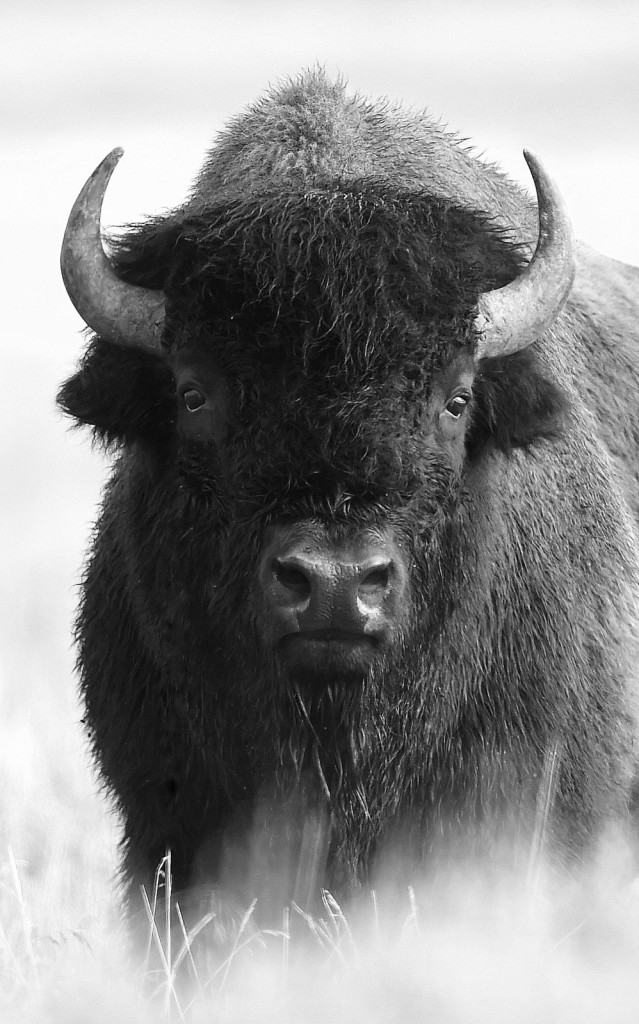 This month’s throwback pinup beauty is a gorgeous bison babe. I don’t know about you, but I find myself getting lost in those big brown eyes (Yes, I realize it is a black and white photo — trust me on this one). That luscious nose. And who wouldn’t want to run their fingers through that luxurious black hair?
This month’s throwback pinup beauty is a gorgeous bison babe. I don’t know about you, but I find myself getting lost in those big brown eyes (Yes, I realize it is a black and white photo — trust me on this one). That luscious nose. And who wouldn’t want to run their fingers through that luxurious black hair?
No doubt about it, that is a half-ton of cuteness right there. Bob the Bison would surely be humming Bob the Marley’s “Looking in your big brown eyes” as he sauntered by this bovine beauty.
The eyes come to life in this image because I was able to capture the elusive “catchlight.” Catchlight is simply the reflection of the sun or light source in the subject’s eyes. Catchlight adds depth and dimension to the eyes and makes the subject come alive. Wildlife photographers obsess about this little dint of illumination – some feel that the foundation of a great wildlife image is catching a bit of ocular sparkle.
Without the glint the human brain seems to not respond as strongly to an image — we tend to see the photo as “lifeless.” Sort of like the difference between looking at a photo of a stuffed toy bison and a picture of well, this Yellowstone beauty. That extra twinkle can make an otherwise “flat” image seem to jump off the page…errr, screen.
The eye glint thing also works for people. So when taking a picture of friends and family, try to capture a bit of catchlight to make your evil ____ more loveable/likable/humanlike. (fill in the blank with the relative or friend of your choice).
The psychological power of catchlight is so strong that sometimes in movies the director will go in the other direction and remove the glint from the eyes of antagonistic characters in post-production to make them seem more evil or heartless.
As you can see, beauty is truly in the eye of the beholder…..or is it the beholdee? Now I’m confused…
Until next month…..michael
Nikon D4s, Nikkor 600mm f/4G ED, 1.4x TC (@850mm), f/5.6, 1/750s, +0.5 EV, ISO 640
31
Shot of the Month – July 2015
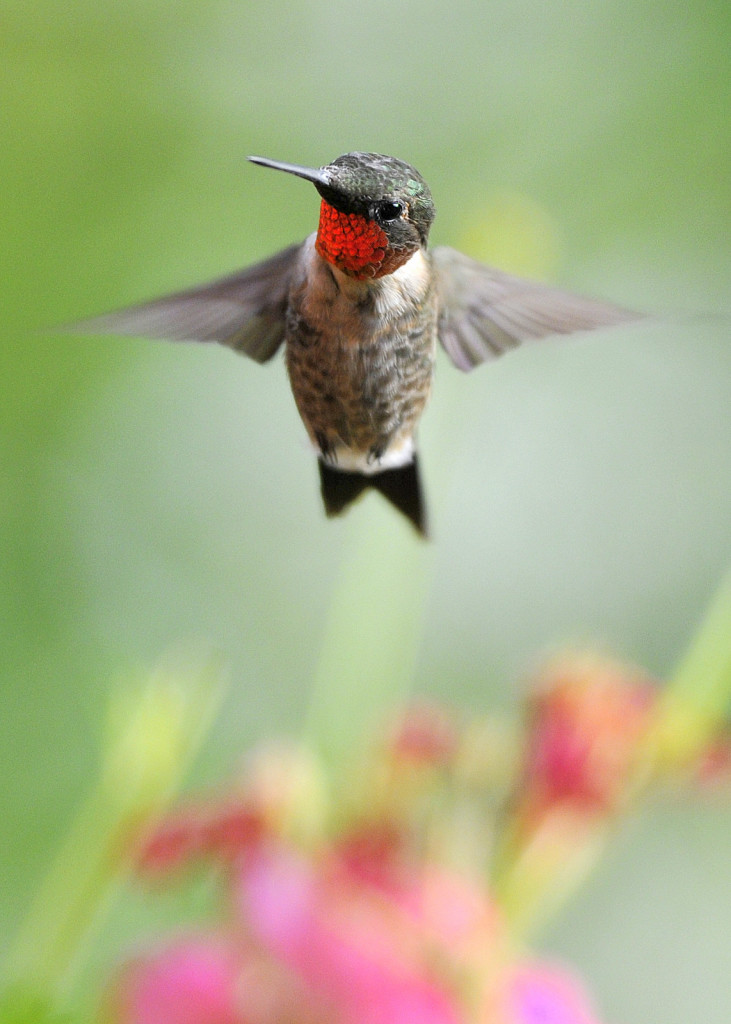 Hummingbirds are the tiny flying jewels of the New World — all 340 known species are distributed among North and South America and the Caribbean. Alas, this wealth is not shared equally. In the eastern US (i.e., east of the Mississippi River) we only have one breeding species, the Ruby-throated hummingbird (RTH), as photographed here in our garden in Vermont. The wealth is shared thusly:
Hummingbirds are the tiny flying jewels of the New World — all 340 known species are distributed among North and South America and the Caribbean. Alas, this wealth is not shared equally. In the eastern US (i.e., east of the Mississippi River) we only have one breeding species, the Ruby-throated hummingbird (RTH), as photographed here in our garden in Vermont. The wealth is shared thusly:
Ecuador: 163 known species (the clear winner)
Columbia: 127 known species
Mexico: 50 known species
North America: 23 known species (most are found west of the Rocky Mountains and south of the US-Mexico border)
The wee birds can be found from southeastern Alaska and western Canada through the United States and Central America (including the Caribbean islands) down to Tierra del Fuego at the southernmost point of South America. The few species that do breed in the US and Canada migrate south to Mexico, Central America, West Indies, and southern Florida for the winter.
Here is a good map showing the distribution of the Ruby-throated hummingbird.
In the spring many RTHs pass through the Yucatan Peninsula of Mexico and fly across the Gulf of Mexico to reach Florida or Louisiana before continuing north. That is a 500-mile non-stop flight over water.
That is also, insane.
A bit of perspective. A RTH weighs about 3 grams. Put a US nickel in your hand — that is about 5 grams. (No, really, I mean it, go find a nickel and hold it. I can wait…….Crazy, right?)
Before departure, the birds go on an eating binge and double their weight to 6 grams. After completing the 20-22 hour, non-stop flight the bird may only weigh 2.5 grams! Once on the mainland, the birds average about 20 miles per day as they continue north. (Source)
In the spring you can use this great map to follow the migration of the Ruby-throated hummingbird.
Until next month…..m
Fade to black as I sit here shaking my head trying to imagine a nickel (with wings, of course) flying 500 miles across open water….
Other Coin Weights for my International Readers:
UK Penny = 3.56 grams
0.10 Euro coin = 4.10 grams
0.05 Euro coin = 3.97 grams
0.02 Euro coin = 3.0 grams
Kenya 10 Shillings coin = 5 grams
Kenya 5 Shillings coin = 3.4 grams
1 Indian Rupee = 4.85 grams
Nikon D300s, Nikon 70-200mm f/2.8G ED VRII (@ f/2.8, 300mm), 1/500 sec, ISO 400
30
Shot of the Month – June 2015
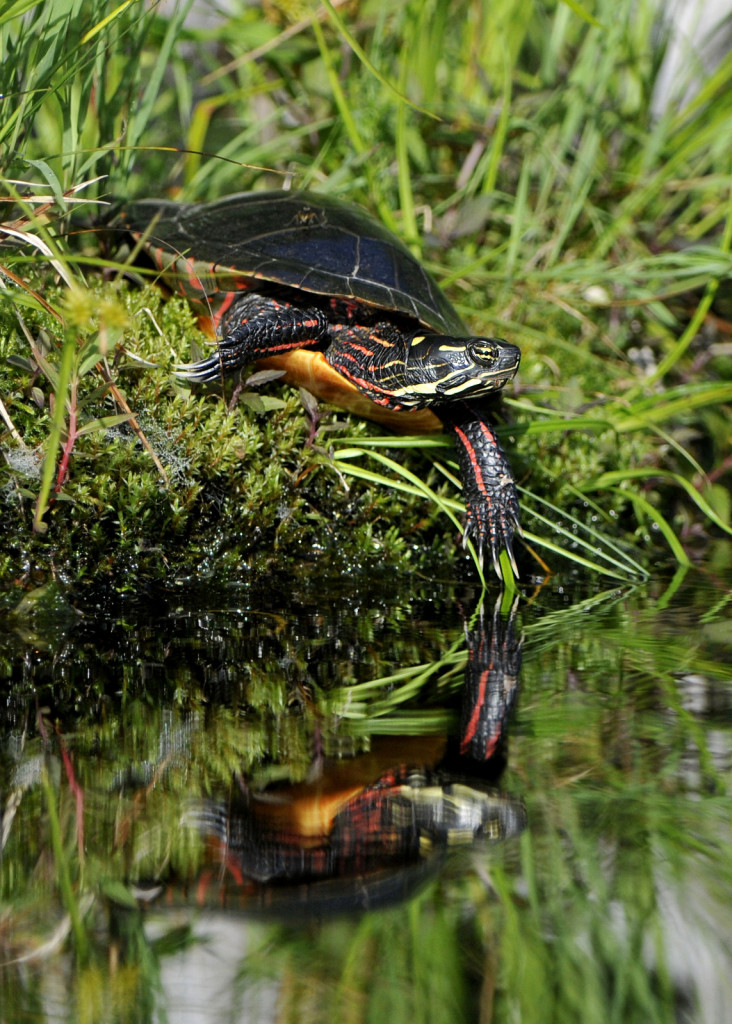 Let me tell you, getting a decent picture of a Painted Turtle is tough. This is not to say that they are hard to find — they are by far the most commonly found turtle in North America.
Let me tell you, getting a decent picture of a Painted Turtle is tough. This is not to say that they are hard to find — they are by far the most commonly found turtle in North America.
They are the only turtle whose native range extends from the Atlantic to the Pacific. These guys can be found in 45 US states and 8 of the 10 Canadian provinces.
As a photographer, the challenge is that the painted turtle is most commonly seen basking in the sun in the late morning. This makes for terrible light and harsh reflections off this shiny creature. Also, these turtles are very skittish so it is very hard to get close before they dive into the water. The joys of nature photography ….grumble, grumble…
There are four regionally based sub-species of painted turtle (eastern, midland, southern, western), with each having slightly different color patterns and size. I photographed this Midland Painted Turtle on a quiet pond in Vermont. Check out the map below to see which type may live near you (Only for you New World types).
Painted turtles like fresh water so if you have visited a pond, lake, marsh, or creek in the US or Canada you most likely have seen one of these fellas.
This is one rock ‘n roll-looking turtle — note the KISS-themed red and yellow stripes on their neck, legs, and tail. And that bad-ass black stripe on the yellow eye. Did you notice the claws on this turtle?! Wolverine has nothing on this guy.
All right, settle down. Back to the science. A few other painted turtle tidbits for you:
- Painted turtles can live up to 55 years in the wild. (they rarely do, but they can)
- Females are larger than males. The extra size allows space for egg production.
- In the winter painted turtles hibernate in mud at the bottom of the body of water where they live. They lower their metabolism so much that they do not need to breathe while in this state. In northern climates, they may hibernate from October to March (Now, THAT is a good nap). Turtles also sleep at the bottom of the water each night — during these periods they can absorb some oxygen through their skin.
- Painted turtles eat assorted plants (e.g. duckweed, algae, and water lilies) and also eat earthworms, insects, leeches, snails, crayfish, frogs, and carrion, to name a few delicacies.
- As they are reptiles painted turtles cannot regulate their body heat. To be active their body temperature has to be between 63-73 degrees F. Each day they go through cycles of activity. First, bask in the sun and build up energy. Then go into the water and hunt for something to eat. Being underwater cools them down, so, bask in the sun again. Once warm, go search for food. Cool off. Bask in the sun. Search for food. You get the idea.
- Painted turtles are the “Official Reptile” of four states: Vermont, Michigan, Illinois, and Colorado. I didn’t even know that was a thing.
There you have it, the painted turtle — Mother Nature’s Rock ‘n Roll playing Marvel Comic Superhero who can be readily found chill’n at your local pond. Until next month…
Nikon D300S, Nikon 200-400mm (@ 260 mm; effective 390mm), f/4, 1/2000 s, ISO 400; handheld from Kayak
30
Shot of the Month – May 2015
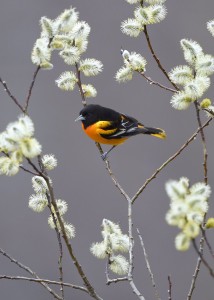 Warning: There may be a bit too much “inside baseball” chatter in this month’s post but stay with me if you can. Or at least, do stop long enough to enjoy the pretty picture.
Warning: There may be a bit too much “inside baseball” chatter in this month’s post but stay with me if you can. Or at least, do stop long enough to enjoy the pretty picture.
As a child, I grew up as a big fan of Baltimore Orioles. My brother and I shared a room and though we rarely agreed on how that space should be apportioned, we both reveled in having a poster of Brooks Robinson on the wall. At this time Boog Powell was a household name as was Frank Robinson and Jim Palmer. Now, if you are a bird lover, but not a baseball fan, not over the age of 50, nor grew up within a hundred miles of Baltimore, you are probably thoroughly confused. And quickly getting bored…
You see I grew up but a mere one-hour drive from the city of Baltimore, Maryland, the home of the Baltimore Orioles baseball team. And it just so happens that their golden era coincided with my youth as they won the World Series in 1966 and 1970. Brooks (3rd base), Boog (1st base), Frank (outfield), and Jim (pitcher) were the all-stars of those glory years.
The only oriole I ever knew of was this guy to the right. (His looks have changed a bit over the years.)
Oddly, for most of my life I never really thought about what the real version of the mascot actually looked like. I had no idea where they lived. I had never seen one even though they are pretty common throughout eastern United States in the summer. I had to come all the way to Vermont to see my first real-life oriole. And the guy in my photo was a particular treat in that he stopped by for a few days just outside our window during the spring last year. We live near the top of a mountain and we hadn’t seen an oriole at such an altitude before — nor since.
The bird and the city are both named after George Calvert. Hang on, I am getting there. George was also known as Lord Baltimore (ahhh…) and he helped colonize what is now Maryland. Ok, that explains the city’s name, but what gives for the bird? The coat of arms for the Calvert family contained a similar color pattern as our avian friend so ye olde bird guys chose that moniker for da bird. The coat of arms shown here is actually for Cecil Calvert, George’s son, but you get the idea. If you know the state flag of Maryland, the coat of arms will look pretty familiar.
Wanna take a guess at the state bird of Maryland?
If you live in the right zip code do yourself a favor and go find a Baltimore Oriole — it is a real visual treat. They can be hard to find however as they tend to hang out at the top of trees. But catch a male in the afternoon light, against a blue sky and his orange chest will beacon like a burning torch — it is stunning to behold. Get out there, you deserve it, hon.
Until next month…m
Nikon D4S, Nikon 600mm, f/4, 1/1000 sec, ISO 560

